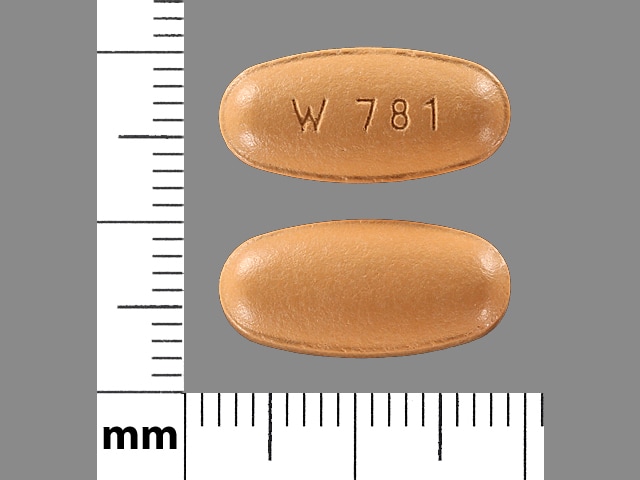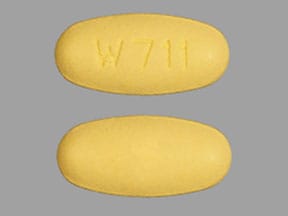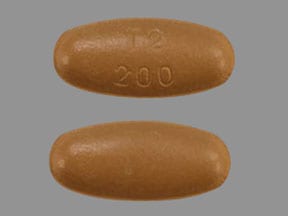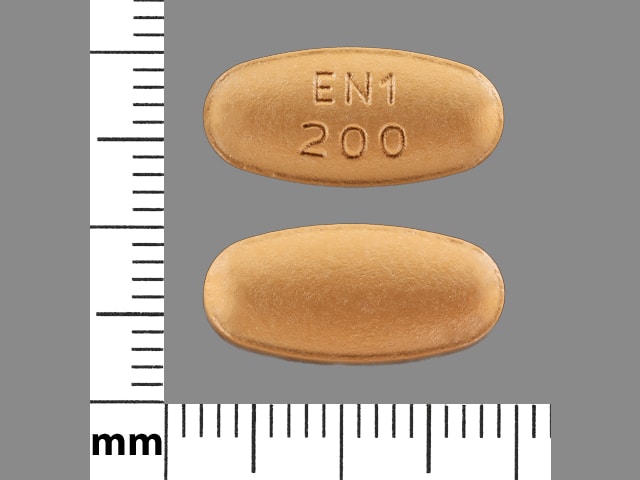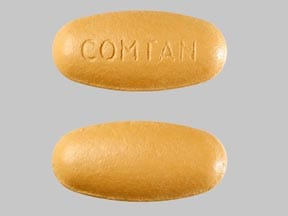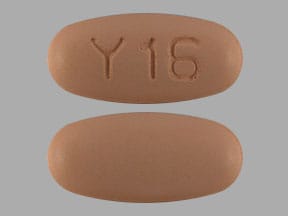Dosage Forms
Excipient information presented when available (limited, particularly for generics); consult specific product labeling.
Tablet, Oral:
Comtan: 200 mg
Generic: 200 mg
Pharmacology
Mechanism of Action
Entacapone is a reversible and selective inhibitor of catechol-O-methyltransferase (COMT). When entacapone is taken with levodopa, the pharmacokinetics are altered, resulting in more sustained levodopa serum levels compared to levodopa taken alone. The resulting levels of levodopa provide for increased concentrations available for absorption across the blood-brain barrier, thereby providing for increased CNS levels of dopamine, the active metabolite of levodopa.
Pharmacokinetics/Pharmacodynamics
Absorption
Rapid
Distribution
IV: Vdss: 20 L
Metabolism
Isomerization to the cis-isomer, followed by direct glucuronidation of the parent and cis-isomer
Excretion
Feces (90%); urine (10%)
Onset of Action
Rapid
Time to Peak
Serum: 1 hour
Half-Life Elimination
Beta phase: 0.4 to 0.7 hours; gamma phase: 2.4 hours
Protein Binding
98%, primarily to albumin
Use in Specific Populations
Special Populations: Hepatic Function Impairment
AUC and Cmax are approximately 2-fold higher in those with a history of alcoholism and hepatic impairment.
Use: Labeled Indications
Parkinson disease: Adjunct to levodopa/carbidopa therapy in patients with idiopathic Parkinson disease who experience “wearing-off” symptoms at the end of a dosing interval
Contraindications
Hypersensitivity to entacapone or any component of the formulation
Canadian labeling: Additional contraindications (not in U.S. labeling): Clinical or laboratory evidence of uncompensated cardiovascular, endocrine, hematologic, pulmonary (including bronchial asthma), or renal disease; history of neuroleptic malignant syndrome (NMS) and/or nontraumatic rhabdomyolysis; hepatic impairment; narrow-angle glaucoma; pheochromocytoma; in the presence of a suspicious, undiagnosed skin lesion or history of melanoma; concomitant use with a nonselective monoamine oxidase (MAO) inhibitor (eg, tranylcypromine, phenelzine) or concomitant use with both a selective MAO-A and selective MAO-B inhibitor; when administration of a sympathomimetic amine is contraindicated
Dosage and Administration
Dosing: Adult
Parkinson disease: Oral: 200 mg with each dose of levodopa/carbidopa, up to a maximum of 8 times daily (maximum daily dose: 1600 mg daily).
Note: To optimize therapy, the dosage of levodopa may need to be reduced or the dosing interval may need to be extended. Patients taking levodopa ≥800 mg daily or who had moderate-to-severe dyskinesias prior to therapy required an average decrease of 25% in the daily levodopa dose.
Dosing: Geriatric
Refer to adult dosing.
Administration
Always administer in association with levodopa/carbidopa; can be combined with both the immediate and sustained release formulations of levodopa/carbidopa. May be administered without regard to meals. Should not be abruptly withdrawn from patient's therapy due to significant worsening of symptoms.
Storage
Store at 25°C (77°F); excursions are permitted between 15°C and 30°C (59°F and 86°F).
Entacapone Images
Drug Interactions
Alcohol (Ethyl): CNS Depressants may enhance the CNS depressant effect of Alcohol (Ethyl). Monitor therapy
Alizapride: May enhance the CNS depressant effect of CNS Depressants. Monitor therapy
Azelastine (Nasal): CNS Depressants may enhance the CNS depressant effect of Azelastine (Nasal). Avoid combination
Blonanserin: CNS Depressants may enhance the CNS depressant effect of Blonanserin. Consider therapy modification
Brexanolone: CNS Depressants may enhance the CNS depressant effect of Brexanolone. Monitor therapy
Brimonidine (Topical): May enhance the CNS depressant effect of CNS Depressants. Monitor therapy
Bromopride: May enhance the CNS depressant effect of CNS Depressants. Monitor therapy
Bromperidol: May enhance the CNS depressant effect of CNS Depressants. Avoid combination
Buprenorphine: CNS Depressants may enhance the CNS depressant effect of Buprenorphine. Management: Consider reduced doses of other CNS depressants, and avoiding such drugs in patients at high risk of buprenorphine overuse/self-injection. Initiate buprenorphine at lower doses in patients already receiving CNS depressants. Consider therapy modification
Cannabidiol: May enhance the CNS depressant effect of CNS Depressants. Monitor therapy
Cannabis: May enhance the CNS depressant effect of CNS Depressants. Monitor therapy
Chlormethiazole: May enhance the CNS depressant effect of CNS Depressants. Management: Monitor closely for evidence of excessive CNS depression. The chlormethiazole labeling states that an appropriately reduced dose should be used if such a combination must be used. Consider therapy modification
Chlorphenesin Carbamate: May enhance the adverse/toxic effect of CNS Depressants. Monitor therapy
CNS Depressants: May enhance the adverse/toxic effect of other CNS Depressants. Monitor therapy
COMT Substrates: COMT Inhibitors may decrease the metabolism of COMT Substrates. Monitor therapy
Dimethindene (Topical): May enhance the CNS depressant effect of CNS Depressants. Monitor therapy
Doxylamine: May enhance the CNS depressant effect of CNS Depressants. Management: The manufacturer of Diclegis (doxylamine/pyridoxine), intended for use in pregnancy, specifically states that use with other CNS depressants is not recommended. Monitor therapy
Dronabinol: May enhance the CNS depressant effect of CNS Depressants. Monitor therapy
Droperidol: May enhance the CNS depressant effect of CNS Depressants. Management: Consider dose reductions of droperidol or of other CNS agents (eg, opioids, barbiturates) with concomitant use. Exceptions to this monograph are discussed in further detail in separate drug interaction monographs. Consider therapy modification
Esketamine: May enhance the CNS depressant effect of CNS Depressants. Monitor therapy
Flunitrazepam: CNS Depressants may enhance the CNS depressant effect of Flunitrazepam. Consider therapy modification
HYDROcodone: CNS Depressants may enhance the CNS depressant effect of HYDROcodone. Management: Avoid concomitant use of hydrocodone and benzodiazepines or other CNS depressants when possible. These agents should only be combined if alternative treatment options are inadequate. If combined, limit the dosages and duration of each drug. Consider therapy modification
HydrOXYzine: May enhance the CNS depressant effect of CNS Depressants. Monitor therapy
Iron Preparations: May decrease the serum concentration of Entacapone. Management: Consider separating doses of the agents by 2 or more hours to minimize the effects of this interaction. Monitor for decreased therapeutic effects of levodopa during concomitant therapy, particularly if doses cannot be separated. Exceptions: Ferric Carboxymaltose; Ferric Derisomaltose; Ferric Gluconate; Ferric Hydroxide Polymaltose Complex; Ferric Pyrophosphate Citrate; Ferumoxytol; Iron Dextran Complex; Iron Sucrose. Consider therapy modification
Kava Kava: May enhance the adverse/toxic effect of CNS Depressants. Monitor therapy
Lemborexant: May enhance the CNS depressant effect of CNS Depressants. Management: Dosage adjustments of lemborexant and of concomitant CNS depressants may be necessary when administered together because of potentially additive CNS depressant effects. Close monitoring for CNS depressant effects is necessary. Consider therapy modification
Lofepramine: Entacapone may enhance the adverse/toxic effect of Lofepramine. Avoid combination
Lofexidine: May enhance the CNS depressant effect of CNS Depressants. Management: Drugs listed as exceptions to this monograph are discussed in further detail in separate drug interaction monographs. Monitor therapy
Magnesium Sulfate: May enhance the CNS depressant effect of CNS Depressants. Monitor therapy
Methotrimeprazine: CNS Depressants may enhance the CNS depressant effect of Methotrimeprazine. Methotrimeprazine may enhance the CNS depressant effect of CNS Depressants. Management: Reduce adult dose of CNS depressant agents by 50% with initiation of concomitant methotrimeprazine therapy. Further CNS depressant dosage adjustments should be initiated only after clinically effective methotrimeprazine dose is established. Consider therapy modification
MetyroSINE: CNS Depressants may enhance the sedative effect of MetyroSINE. Monitor therapy
Minocycline (Systemic): May enhance the CNS depressant effect of CNS Depressants. Monitor therapy
Monoamine Oxidase Inhibitors: COMT Inhibitors may enhance the adverse/toxic effect of Monoamine Oxidase Inhibitors. Consider therapy modification
Nabilone: May enhance the CNS depressant effect of CNS Depressants. Monitor therapy
Opioid Agonists: CNS Depressants may enhance the CNS depressant effect of Opioid Agonists. Management: Avoid concomitant use of opioid agonists and benzodiazepines or other CNS depressants when possible. These agents should only be combined if alternative treatment options are inadequate. If combined, limit the dosages and duration of each drug. Consider therapy modification
Orphenadrine: CNS Depressants may enhance the CNS depressant effect of Orphenadrine. Avoid combination
Oxomemazine: May enhance the CNS depressant effect of CNS Depressants. Avoid combination
OxyCODONE: CNS Depressants may enhance the CNS depressant effect of OxyCODONE. Management: Avoid concomitant use of oxycodone and benzodiazepines or other CNS depressants when possible. These agents should only be combined if alternative treatment options are inadequate. If combined, limit the dosages and duration of each drug. Consider therapy modification
Paraldehyde: CNS Depressants may enhance the CNS depressant effect of Paraldehyde. Avoid combination
Perampanel: May enhance the CNS depressant effect of CNS Depressants. Management: Patients taking perampanel with any other drug that has CNS depressant activities should avoid complex and high-risk activities, particularly those such as driving that require alertness and coordination, until they have experience using the combination. Consider therapy modification
Pipamperone [INT]: COMT Inhibitors may diminish the therapeutic effect of Pipamperone [INT]. Pipamperone [INT] may diminish the therapeutic effect of COMT Inhibitors. Monitor therapy
Piribedil: CNS Depressants may enhance the CNS depressant effect of Piribedil. Monitor therapy
Pramipexole: CNS Depressants may enhance the sedative effect of Pramipexole. Monitor therapy
ROPINIRole: CNS Depressants may enhance the sedative effect of ROPINIRole. Monitor therapy
Rotigotine: CNS Depressants may enhance the sedative effect of Rotigotine. Monitor therapy
Rufinamide: May enhance the adverse/toxic effect of CNS Depressants. Specifically, sleepiness and dizziness may be enhanced. Monitor therapy
Selective Serotonin Reuptake Inhibitors: CNS Depressants may enhance the adverse/toxic effect of Selective Serotonin Reuptake Inhibitors. Specifically, the risk of psychomotor impairment may be enhanced. Monitor therapy
Sodium Oxybate: May enhance the CNS depressant effect of CNS Depressants. Management: Consider alternatives to combined use. When combined use is needed, consider minimizing doses of one or more drugs. Use of sodium oxybate with alcohol or sedative hypnotics is contraindicated. Consider therapy modification
Suvorexant: CNS Depressants may enhance the CNS depressant effect of Suvorexant. Management: Dose reduction of suvorexant and/or any other CNS depressant may be necessary. Use of suvorexant with alcohol is not recommended, and the use of suvorexant with any other drug to treat insomnia is not recommended. Consider therapy modification
Tapentadol: May enhance the CNS depressant effect of CNS Depressants. Management: Avoid concomitant use of tapentadol and benzodiazepines or other CNS depressants when possible. These agents should only be combined if alternative treatment options are inadequate. If combined, limit the dosages and duration of each drug. Consider therapy modification
Tetrahydrocannabinol: May enhance the CNS depressant effect of CNS Depressants. Monitor therapy
Tetrahydrocannabinol and Cannabidiol: May enhance the CNS depressant effect of CNS Depressants. Monitor therapy
Thalidomide: CNS Depressants may enhance the CNS depressant effect of Thalidomide. Avoid combination
Trimeprazine: May enhance the CNS depressant effect of CNS Depressants. Monitor therapy
Zolpidem: CNS Depressants may enhance the CNS depressant effect of Zolpidem. Management: Reduce the Intermezzo brand sublingual zolpidem adult dose to 1.75 mg for men who are also receiving other CNS depressants. No such dose change is recommended for women. Avoid use with other CNS depressants at bedtime; avoid use with alcohol. Consider therapy modification
Adverse Reactions
>10%:
Gastrointestinal: Nausea (14%)
Neuromuscular & skeletal: Dyskinesia (25%)
1% to 10%:
Cardiovascular: Syncope (1%)
Central nervous system: Dizziness (8%), fatigue (6%), anxiety (2%), drowsiness (2%), agitation (1%), hallucination (≤1%)
Dermatologic: Diaphoresis (increased; 2%)
Gastrointestinal: Diarrhea (10%), abdominal pain (8%), constipation (6%), vomiting (4%), xerostomia (3%), dyspepsia (2%), flatulence (2%), dysgeusia (1%), gastritis (1%), gastrointestinal disease (1%)
Genitourinary: Urine discoloration (brown-orange; 10%)
Hematologic & oncologic: Purpura (2%)
Infection: Bacterial infection (1%)
Neuromuscular & skeletal: Hyperkinesia (10%), hypokinesia (9%), back pain (2% to 4%), weakness (2%)
Respiratory: Dyspnea (3%)
<1%, postmarketing, and/or case reports: Behavioral changes (including psychotic-like behavior), hepatitis (mainly cholestatic features), impulse control disorder (eg, pathological gambling, hypersexuality, spending money), mental status changes, neurological signs and symptoms (hyperpyrexia and confusion [resembling neuroleptic malignant syndrome]), orthostatic hypotension, pulmonary fibrosis, retroperitoneal fibrosis, rhabdomyolysis, sudden onset of sleep
Warnings/Precautions
Concerns related to adverse effects:
- Abnormal thinking/behavioral changes: Abnormal thinking and behavior changes have been reported and may include aggressive behavior, agitation, confusion, delirium, delusions, disorientation, paranoid ideation, and psychotic-like behavior.
- Diarrhea: Has been associated with delayed development of diarrhea (usual onset after 4 to 12 weeks); use with caution in patients with lower gastrointestinal disease or an increased risk of dehydration. Diarrhea may be a sign of drug-induced colitis (primarily lymphocytic). Monitor for weight loss. Discontinue use with prolonged diarrhea.
- Dyskinesia: New-onset or exacerbation of preexisting dyskinesia may occur when used as an adjunct to levodopa. Decreasing the dose of levodopa may ameliorate these side effects in some cases.
- Hallucinations: May cause hallucinations.
- Impulse control disorders: Compulsive behaviors and/or loss of impulse control, which has manifested as pathological gambling, libido increases (hypersexuality), intense urges to spend money uncontrollably, and other intense urges have been reported. Dose reduction or discontinuation of therapy has been reported to reverse these behaviors in some, but not all cases.
- Melanoma: Risk for melanoma development is increased in Parkinson disease patients; drug causation or factors contributing to risk have not been established. Patients should be monitored closely and periodic skin examinations should be performed. The Canadian labeling contraindicates use in patients with suspicious, undiagnosed skin lesions or history of melanoma.
- Neuroleptic malignant syndrome: Entacapone, in conjunction with other drug therapy that alters brain biogenic amine concentrations (eg, MAO inhibitors, SSRIs), has been associated with a syndrome resembling neuroleptic malignant syndrome (hyperpyrexia and confusion - some fatal) on abrupt withdrawal or dosage reduction. Concomitant use of entacapone and nonselective MAO inhibitors should be avoided.
- Orthostatic hypotension: May cause orthostatic hypotension and syncope.
- Pleural/retroperitoneal fibrosis: Dopaminergic agents from the ergot class have been associated with fibrotic complications, such as retroperitoneal fibrosis, pulmonary infiltrates or pleural effusion and thickening. These complications may resolve when the drug is discontinued, but complete resolution does not always occur. It is unknown whether nonergot, pro-dopaminergic agents like entacapone confer this risk.
- Rhabdomyolysis: Severe rhabdomyolysis has been reported with use.
- Somnolence: Patients have reported falling asleep while engaging in activities of daily living; this has been reported to occur without significant warning signs and may occur as late as up to 1 year after initiation of treatment. Monitor for daytime somnolence or preexisting sleep disorder. Use caution in the presence of sleep disorders, with other CNS depressants, sedating agents, psychoactive drugs or ethanol. Patients must be cautioned about performing tasks which require mental alertness (eg, operating machinery or driving).
Disease-related concerns:
- Cardiovascular disease: The Canadian product labeling notes to use with caution in patients with cardiovascular disease, including a history of myocardial infarction (MI) and arrhythmias; MI and other ischemic adverse events have been observed in clinical trials.
- Hepatic impairment: Use with caution in patients with hepatic impairment or biliary obstruction. The Canadian labeling contraindicates use in hepatic impairment.
- Psychotic disorders: Avoid use in patients with major psychotic disorder due to the risk of exacerbating psychosis. Many treatments for psychosis may exacerbate the symptoms of Parkinson disease and may also decrease the effectiveness of entacapone.
Concurrent drug therapy issues:
- Drug-drug interactions: Potentially significant interactions may exist, requiring dose or frequency adjustment, additional monitoring, and/or selection of alternative therapy. Consult drug interactions database for more detailed information.
- Sedatives: Effects with other sedative drugs or ethanol may be potentiated.
Other warnings/precautions:
- Discontinuation of therapy: Do not withdraw therapy abruptly.
- Urine discoloration: Urine may appear dark in color (brownish orange) during therapy.
Monitoring Parameters
Signs and symptoms of Parkinson's disease; liver function tests, blood pressure, patient's mental status and impulse control disorders; daytime sleepiness; serum iron (if signs of anemia); weight loss (patients experiencing diarrhea); signs and symptoms of neuroleptic malignant syndrome if abrupt discontinuation required; dermatologic examination (regularly while on therapy).
Canadian labeling (additional monitoring recommendations): Cardiac function with initial dosage adjustments and periodically during prolonged therapy (patients with history of MI or arrhythmia)
Pregnancy
Pregnancy Considerations
The incidence of Parkinson disease in pregnancy is relatively rare and information related to the use of entacapone in pregnant women is very limited (Kranick 2010; Tüfekçioğlu 2018).
Patient Education
What is this drug used for?
- It is used to treat Parkinson disease.
Frequently reported side effects of this drug
- Loss of strength and energy
- Nausea
- Vomiting
- Constipation
- Dry mouth
Other side effects of this drug: Talk with your doctor right away if you have any of these signs of:
- Low potassium like muscle pain or weakness, muscle cramps, or an abnormal heartbeat.
- Dehydration like dry skin, dry mouth, dry eyes, increased thirst, fast heartbeat, dizziness, fast breathing, or confusion.
- Severe dizziness
- Passing out
- Confusion
- Severe or persistent diarrhea
- Severe abdominal pain
- Muscle pain
- Muscle weakness
- Stiff muscles
- Uncontrollable urges
- Abnormal movements
- Shortness of breath
- Sensing things that seem real but are not
- Mood changes
- Behavioral changes
- Skin growth
- Mole changes
- Narcolepsy
- Signs of a significant reaction like wheezing; chest tightness; fever; itching; bad cough; blue skin color; seizures; or swelling of face, lips, tongue, or throat.
Note: This is not a comprehensive list of all side effects. Talk to your doctor if you have questions.
Consumer Information Use and Disclaimer: This information should not be used to decide whether or not to take this medicine or any other medicine. Only the healthcare provider has the knowledge and training to decide which medicines are right for a specific patient. This information does not endorse any medicine as safe, effective, or approved for treating any patient or health condition. This is only a brief summary of general information about this medicine. It does NOT include all information about the possible uses, directions, warnings, precautions, interactions, adverse effects, or risks that may apply to this medicine. This information is not specific medical advice and does not replace information you receive from the healthcare provider. You must talk with the healthcare provider for complete information about the risks and benefits of using this medicine.
